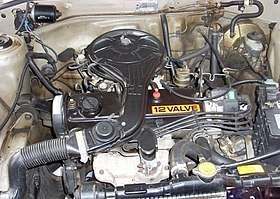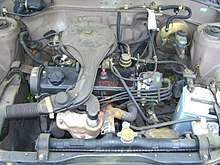Toyota E engine
The Toyota E engine family is a straight-four piston engine series, and uses timing belts rather than chains. The E engines were the first multi-valve engines from Toyota designed with economy, practicality and everyday use in mind (rather than performance). Like many other Toyota engines from the era, the E engine series features a cast iron block, along with an aluminium cylinder head. E engines are lighter compared to earlier Toyota engines, due the hollow crankshaft, thinned casting of the cylinder block, and several other reductions in auxiliaries as well as in the engine itself. Carbureted versions include a newly designed, variable-venturi carburetor. All of these changes improved economy and emissions.[1] The members of the E engine family, range from 1.0 L to 1.5 L. The E family supplanted the K engines in most applications. A large number of parts in the E engine series are interchangeable between each other.
| Toyota E engine | |
|---|---|
 2E engine | |
| Overview | |
| Manufacturer | Toyota |
| Production | 1985–1999 |
| Layout | |
| Configuration | Straight-four |
| Block material | Cast iron |
| Head material | Aluminum |
| Valvetrain | SOHC, DOHC |
| Combustion | |
| Turbocharger | In some versions |
| Fuel system | Carbureted, Fuel injected |
| Fuel type | Gasoline |
| Cooling system | Water-cooled |
| Output | |
| Power output | 55–133 hp (41–99 kW) |
| Torque output | 72–127 lb⋅ft (98–172 N⋅m) |
| Chronology | |
| Predecessor | Toyota K engine (up to 1.3 L models) |
| Successor | Toyota SZ engine (for 1.0 L and 1.3 L models) Toyota NZ engine (for 1.3 L and 1.5 L models) |
1E
The 1E is a 1.0 L (999 cc) carbureted 12-valve SOHC engine. Bore and stroke is 70.5 mm × 64 mm (2.78 in × 2.52 in). Compression ratio is 9.0:1. It appeared in 1985. Output ranges to about 55 hp (41 kW) at 6,000 rpm, while torque is 102 N⋅m (75 lb⋅ft) at 3,500 rpm.
- Specs[2]
- Bore x stroke: 70.5 mm × 64 mm (2.78 in × 2.52 in)
- Displacement: 1.0 L (999 cc)
- Valve clearance: Intake: 0.2 mm (0.01 in); Exhaust: 0.2 mm (0.01 in)
- Ignition timing (with vacuum advancer off): 10 degrees BTDC
- Oil capacity: 3.2 L (3.4 US qt)
- Gearbox
- 4-speed manual gearbox: C140
- Automatic transmission: ***
- Applications
- Toyota Starlet#P70 EP70, EP80.
2E

The 2E is a 1.3 L (1,295 cc) SOHC version with three valves per cylinder. Output ranges from 65 to 82 hp (48 to 61 kW; 66 to 83 PS) at 6,000 rpm with 72 lb⋅ft (98 N⋅m) of torque at 3600 rpm to 77 lb⋅ft (104 N⋅m) of torque at 5200 rpm. It appeared in 1985, and was discontinued after 1998. The 2E engines appeared in both carbureted and fuel-injected (called 2E-E) versions. The 2E-TE, appearing in 1986, is a turbocharged engine producing 101 hp (75 kW; 102 PS). A later version, the 2E-TELU produces 110 hp (82 kW; 112 PS).
- Specs[2]
- Bore x stroke: 73 mm × 77.4 mm (2.87 in × 3.05 in)
- Displacement: 1.3 L (1,295 cc)
- Compression ratio: 9.5:1
- Ignition timing (with vacuum advancer off): 10 degrees BTDC
- Ignition timing (as per Haynes Databook): 5 degrees BTDC at 800 rpm
- Gearbox
- Applications
- AE92, AE111 Toyota Corolla (South Africa)
- Toyota Corolla/Toyota Sprinter EE80, EE90, EE96, EE97, EE100
- Toyota Starlet EP71, EP81, EP82 (2E-E,Si Version), EP90
- Toyota Starlet EP76V Van (2E-LJ) - 73 PS (54 kW; 72 hp) at 6,000 rpm, 10.3 kg⋅m (101 N⋅m; 75 lb⋅ft) at 4,000 rpm[3]
- Toyota Corsa
- Toyota Conquest (South Africa)
- Toyota Tazz (South Africa)
- Toyota Tercel (Caribbean/South America/Middle East)
3E
The 3E is a 1.5 L (1,456 cc) SOHC version with three valves per cylinder. Output ranges from 79 to 88 PS (58 to 65 kW; 78 to 87 hp) at 6,000 rpm with 87 lb⋅ft (118 N⋅m) of torque at 4,000 rpm to 89 lb⋅ft (121 N⋅m) of torque at 4,800 rpm. It appeared in 1986, and was discontinued after 1994. The 3E engines appeared in both carbureted (3E) and fuel-injected (3E-E) applications. The 3E-TE, appearing in 1986, is a turbocharged engine producing 115 PS (85 kW; 113 hp) at 5,600 rpm with 17.5 kg⋅m (172 N⋅m; 127 lb⋅ft) of torque at 3,200 rpm.
- Specs
- Bore x stroke 73 mm × 87 mm (2.87 in × 3.43 in)
- 9.3:1 compression ratio (8.0:1 3E-TE)
- Applications
- Toyota Corolla/Sprinter EE98V (van)
- Toyota Corolla/Sprinter EE107V/EE108G (van/wagon)
- Toyota Corona ET176V (van)
- Toyota Tercel/Corolla II/Corsa EL31
The 3E and 3E-E engines are considered slightly less reliable than other Toyota engines, although they are also among the easiest engines to service. The most common problems affecting these engines are premature valve stem seal (nitrile rubber) failure, carbon buildup on the intake valves, and collapse of the oil control ring on the piston. Any of these conditions can lead to rough idling, stalling, and fouled spark plugs, and therefore need to be differentially diagnosed. The valve stem seals, at least, can be replaced with silicone or Viton-based seals which last much longer.[4]
4E
The 4E is a 1.3 L (1,331 cc) DOHC version. Bore and stroke is 74 mm × 77.4 mm (2.91 in × 3.05 in). Output ranges from 74 hp (55 kW; 75 PS) at 6,400 rpm to 99 hp (74 kW; 100 PS) at 6,600 rpm with 81 lb⋅ft (110 N⋅m) of torque at 3,600 rpm to 86 lb⋅ft (117 N⋅m) of torque at 4,000 rpm. It appeared in 1989, and was discontinued after 1998. The 4E engines appeared in fuel-injected applications.
- Applications
- Toyota Starlet EP82, EP85, EP91, EP95
- Toyota Tercel
- Toyota Corolla
- Toyota Paseo
- Toyota Cynos
First generation 4E-FE
The first generation of 4E engines found in the Starlet GI, Soleil and Corolla models were produced from 1989 until 1996. The engine found in these two models produces 88 bhp (66 kW; 89 PS) at 6,600 rpm and 86 lb⋅ft (117 N⋅m) at 5,200 rpm. This engine has more in common with the 4E-FTE, sharing the same throttle body, and slightly larger fuel injectors.
- Specs
- Bore x stroke 74 mm × 77.4 mm (2.91 in × 3.05 in)
- 9.6:1 compression ratio
Second generation 4E-FE
The second generation of the 4E-FE was introduced in 1996 producing less peak power: 75 PS (55 kW; 74 hp) at 5,500 rpm, but with a slight increase in peak torque 87 lb⋅ft (118 N⋅m) at 4,400 rpm. The second generation of the 4E-FE is essentially the same engine as the first but the intake and exhaust manifolds were changed along with a slight alteration of the ECU meant to reduce exhaust emissions.
- Specs
- Bore x stroke 74.3 mm × 77.4 mm (2.93 in × 3.05 in)
- 9.6:1 compression ratio
Third generation 4E-FE
In 1997 the intake manifold was changed again along with the ECU and the result was 85 PS (63 kW; 84 hp) for the Corolla and 82 PS (60 kW; 81 hp) for the Starlet. This engine was discontinued in 1999.
4E-FTE
The first generation of the 4E-FE was the basis of the 4E-FTE in 1989, which is a turbocharged engine producing 135 PS (99 kW; 133 hp) at 6,400 rpm with 116 lb⋅ft (157 N⋅m) of torque at 4,800 rpm. The 4E-FTE is the most powerful of the E series engines ever produced. It was produced exclusively for the Toyota Starlet GT Turbo (Japan Only) and its successor, the Toyota Glanza V (Japan only). However the 4E-FTE was a very popular conversion engine by enthusiasts for many small Toyota cars such as the Corolla, Tercel, Paseo and Sera which it fit into with standard Toyota parts. The 4E-FTE differs internally from the 4E-FE with its stronger connecting rods, lower compression pistons (reduced from 9.6:1 to 8.5:1) and stronger crankshaft. The cylinder head and valve train are identical to the 4E-FE. The 4E-FTE also features a harmonic damper instead of a normal crankshaft pulley. The turbocharger fitted to the 4E-FTE was Toyota's own CT9 model, which features an internal waste gate and has two modes: low 0.4 bar (5.8 psi) and high 0.65 bar (9.4 psi) boost. The low boost mode is electronically controlled by a solenoid valve and the ECU and the high boost is controlled by an actuator connected to the turbocharger. The 4E-FTE also has a top-mounted, air-cooled intercooler. The 4E-FTE is mated to the Toyota C52 transmission (for the EP82 Starlet GT) and the C56 transmission (for the EP91 Glanza V).
- Specs
- Bore x stroke 74 mm × 77.4 mm (2.91 in × 3.05 in)
- 8.5:1 compression ratio
5E
The 5E is a 1.5 L (1,497 cc) DOHC 16-valve version. Output ranges from 93 hp (69 kW; 94 PS) at 5,400 rpm to 110 PS (81 kW; 108 hp) at 6,400 rpm with 91 lb⋅ft (123 N⋅m) of torque at 3,200 rpm to 100 lb⋅ft (136 N⋅m) of torque at 4,000 rpm. It was introduced in 1990 and discontinued in 1998. All 5E engines are fuel-injected. In 1995 Toyota changed the ignition system to a distributor-less (DIS), coil-on-plug design, switched from OBD to OBD-II and began using flat topped pistons. This ignition design uses two coils. Each coil mounts on top of a spark plug, but also has a cable run to another cylinder's spark plug. This is known as a "wasted spark design". It is electrically similar to engines that have a coil pack. The spark plug fires in both directions (center-to-side, and side-to-center). Double platinum plugs are used with this engine to prevent premature side electrode wear. A much thinner 0.26 mm (0.01 in) head gasket is used to increase compression after the piston domes were removed, and dual electrode spark plugs were installed on California emission models. In 1996 the connecting rods changed to the same thinner ones used in the second generation 4E-FE. In 1997 a return-less fuel system was added.
- Specs
- Bore x stroke 74 mm × 87 mm (2.91 in × 3.43 in)
- 9.4:1 compression ratio
- Applications
- Toyota Paseo
- Toyota Sera
- Toyota Tercel
- Toyota Raum
- Toyota Corolla
- Toyota Corsa
- Toyota Caldina
- Toyota Corolla II
- Toyota Cynos
- Toyota Vios
5E-FHE
Maximum power was increased to 110 PS (81 kW; 108 hp). The maximum engine speed was increased to 7,200 rpm in the first generation, and 7,900 for the second generation. It uses the harmonic damper from the 4E-FTE, more aggressive intake and exhaust cams, some versions (not the Sera) have the ACIS intake, high compression pistons, 4-2-1 exhaust headers, and stronger internals (i.e. the "fat" connecting rods found in the first generation 5E-FE).
References
- Tekniikan Maailma magazine (in Finnish) (#4). 1985. Missing or empty
|title=(help) - Toyota EP80 Owners Manual
- Super Business Vehicle: Starlet Van (catalog) (in Japanese), Tokyo: Toyota Motor Co, March 1987, p. 6, 171043-6203
- Tercel online message board